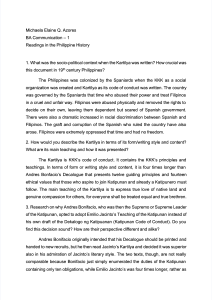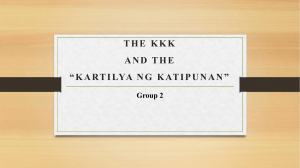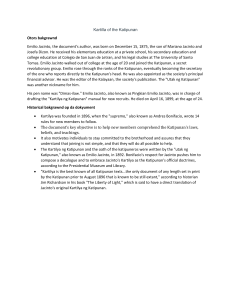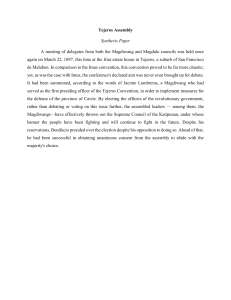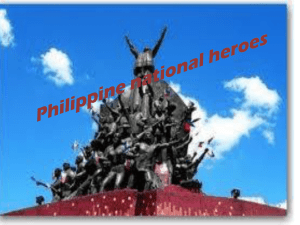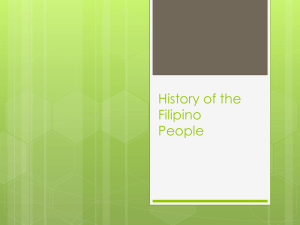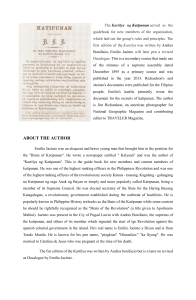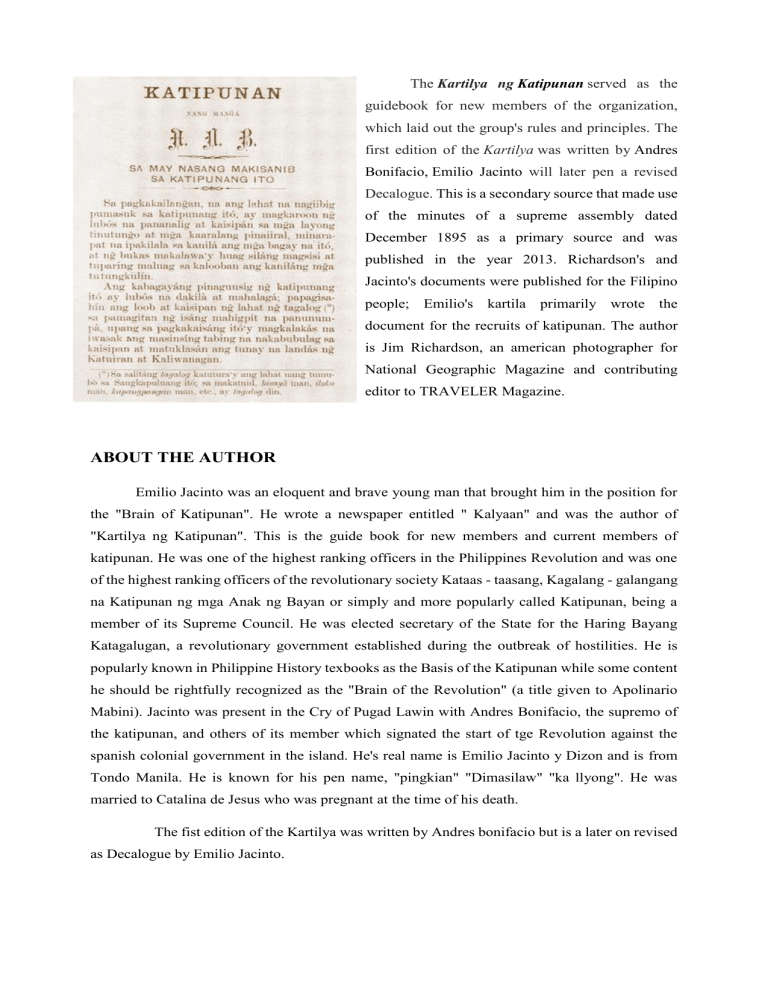
The Kartilya ng Katipunan served as the guidebook for new members of the organization, which laid out the group's rules and principles. The first edition of the Kartilya was written by Andres Bonifacio, Emilio Jacinto will later pen a revised Decalogue. This is a secondary source that made use of the minutes of a supreme assembly dated December 1895 as a primary source and was published in the year 2013. Richardson's and Jacinto's documents were published for the Filipino people; Emilio's kartila primarily wrote the document for the recruits of katipunan. The author is Jim Richardson, an american photographer for National Geographic Magazine and contributing editor to TRAVELER Magazine. ABOUT THE AUTHOR Emilio Jacinto was an eloquent and brave young man that brought him in the position for the "Brain of Katipunan". He wrote a newspaper entitled " Kalyaan" and was the author of "Kartilya ng Katipunan". This is the guide book for new members and current members of katipunan. He was one of the highest ranking officers in the Philippines Revolution and was one of the highest ranking officers of the revolutionary society Kataas - taasang, Kagalang - galangang na Katipunan ng mga Anak ng Bayan or simply and more popularly called Katipunan, being a member of its Supreme Council. He was elected secretary of the State for the Haring Bayang Katagalugan, a revolutionary government established during the outbreak of hostilities. He is popularly known in Philippine History texbooks as the Basis of the Katipunan while some content he should be rightfully recognized as the "Brain of the Revolution" (a title given to Apolinario Mabini). Jacinto was present in the Cry of Pugad Lawin with Andres Bonifacio, the supremo of the katipunan, and others of its member which signated the start of tge Revolution against the spanish colonial government in the island. He's real name is Emilio Jacinto y Dizon and is from Tondo Manila. He is known for his pen name, "pingkian" "Dimasilaw" "ka llyong". He was married to Catalina de Jesus who was pregnant at the time of his death. The fist edition of the Kartilya was written by Andres bonifacio but is a later on revised as Decalogue by Emilio Jacinto. CONTENT OF THE TOPIC The Kataas-taasan, kagalanggalangang na katipunan ng mga Anak ng Bayan (KKK) or Katipunan is arguably the most important organization formed in the Philippine History. The two principal aims of the KKK as gathered from the writings of Bonifacio. • Unity of the Filipino People • Separation from Spain by means of revolution It was written to let the joining members of KKK to have a full knowledge and understanding of the principles they have to live by. The Kartilla ng Katipunan by Jim on the other hand was written for the Filipino People. It is composed of 14 rules that instruct the way a katipunero should behave. This is also treated as the katipunans code of conduct. Each paragraph is unique in such a way that they tackle different aspects of a person’s life. In which case, anyone may have different interpretation. Hence, it is only appropriate to have a better understanding or explanation to its contents. The first highlights the significance of living life with a purpose. “A Katipunero who does not have a purpose lives is a useless life.” This tenet actually defines what life is. Life is a gift given to everyone that must be treasured by making it meaningful through setting up goals and achieving it no matter how hard it is. The second rule is about doing what is right. “A deed carried out for the sake of fame is not worthy of praise.” There are certain things in life that would make others proud because of you but sometimes it’s done just to be popular. Everyone must bear in mind that doing good must be accompanied with humbleness. A deed that is done must be because of what someone really feels like doing to help other people. The third shows what the true meaning of kindness is. “True act of kindness for a Katipunero is in the love and service he render to other people and not the other way round.” It only means that having an open hand to give help without expecting in return is one of the best example to show an act kindness. The fourth rule highlights equality among people. “Every Katipuneros are treated equally no matter what race or educational background he has. “ Status and Identity will never be the reason for unequal treatment of people. Whether they are Filipinos or not, rich or poor, men or women, and white or black, nobody deserves to be discriminated. The Fifth shows what honor should mean for a Katipunero. “A true Katipunero values Honor more than his personal interests.” The sixth is about doing the “walk the talk” concept or putting into action the words that has been promised. “A Katipunero who has a sense of shame must be a man of his own word.” The seventh rule gives importance to how we manage our time and give our best like tomorrow ends because time is as precious as a gold. “A Katipunero must give importance to time. For the Katipunan, a time lost will never be back.” The eighth lesson simply tells everyone to fight for what is right and fight with the persons who is at the right side. “A Katipunero must protect the weak and fight for those who oppress the weak.” The ninth is about the significance of trust that everyone must know how to keep confidential things in order to keep the trust that other people give. “A Katipunero is careful with what he says and keeps the things that must be kept secret.” The tenth principle is all about being able to lead the family. “A Katipunero must lead his family to the right path. If the leader is consumed by evil, so does his followers.” The eleventh highlights everything a man must look at woman’s identity. “A Katipunero must give importance to woman. He must not see her as an object, nor pat time. That whenever a Katipunero sees a woman, he will remember his mother who nurtured him.” The twelfth principle gives importance to every action that one has to make. “A Katipunero must not do the things that he does not want to be done by him.” The thirteenth rule is about one’s knowledge on how to have a right character in dealing with life. “A Katipuneros’ life is not measured by what is his status in life nor with the things he possess. Instead, it is in his character and his love for the native land. The Last shows the idea of the author’s desire. It emphasizes the hope he has for everyone and believes that every sacrifices that a Katipunero make will always be worth it. Kartilya ng Katipunan is a set of principles that shows the path on how each and every one of us must live of lives by living to the fullest through good values. I believe that this Kartilya ng Katipunan was made to change the thoughts of every Filipino’s unacceptable behavior. Katipunan was not just an organization working towards the freedom of the Filipinos. They built on the ideological and political foundation constructed by men and women who sacrificed themselves because of their love for the country and for the people. Just like Rizal who pushed Filipinos to think critically with full understanding, this code of conduct was made to inform people of what they deserve to know for making their lives better. Going back to the past, the journey to freedom is long and hard. The price of bravery and principle is high. Back then, they thought that the day of real freedom will forever remain a dream. And through Kartilya ng Katipunan, Filipinos were united to fight for what they own. Kartilya ng Katipunan became an oath the every Katipuneros must follow to show their determination in being a part of the people who wanted a change. And while we have different interpretation with what was intended by Bonifacio, there is one thing that everyone can agree on: Kartilya ng Katipunan was meant to guide us in living our everyday life to the fullest. More importantly, it highlights the importance of having the right attitude towards other people. IMPORTANCE OF KARTILYA NG KATIPUNAN This published material of Emilio Jacinto serve as a great contributor of our history back then as well as today. Given that this book covers moral values, certain norms, principle and guide for all the Katipuneros on the time-being of Sapanish Colonial. Jacinto also defined the true diety (kabanalan) as charity, love for one another, deeds and speech guided by judicous reason. For an instance, this contains guides and laws that prominent katipuneros abide, Jacinto point out that katipuneros should be fair and just no matter what race you come from and what gender you have. As well as unfairly treat of woman should not be practiced. On that time, this book be able to help Katipuneros to reflect themselves. This book been able to put a good mark on our history as the katipuneros back then were guided by this Kartilya and left us to understand what was living is. Leaving us the word Katipunero Ideology. Therefore, Primer of the Katipunero served as a great contribution on lur history and to all Filipino as well, leaving a good moral character and shaping ourselves to mold a better world For the Katipunan leadership, such as Emilio Jacinto, the ideas of Right and Light, Katwiran and Kaliwanagan, were of utmost importance. They saw themselves as not only as inheritors of the Age of Enlightenment, but intellectual and moral revolutionaries fighting to create and define a nation and culture that was post-Enlightenment; that was no longer shackled by the ideological and colonial restraints of the West, but a country that adopted and merged the best of Spain, the United States, France, and our own unique culture and society, in support of being Filipino. The Kartilya was the moral and intellectual foundation used to guide the actions of Katipuneros. Upon joining the Katipunan, members were required to read the Kartilya and adhere to its code of conduct. Changing the way people thought and acted was paramount to the early Katipuñeros; they understand that was the only way to truly change the Philippines for the better. Play-acting as and implicitly referencing the Katipunan without fully understanding their political and moral context and goals essentially degrades the breadth of what they were trying to achieve. Then again, we always forget that the Katipunan, upon inception and in action, was not the mass movement it is commonly mooted as, but one of the middle class, even the upper middle class. In the context of 19th century Philippines, these men were highly educated and socially mobile. They were critically thinking, well read, and (in some cases) well traveled individuals who conceptualized a new Philippines. One founded on egalitarianism, even while recognizing that social differences will exist. Of course the Katipunan was not the only organization working towards independence. They built on the ideological and political foundation constructed by men and women who sacrificed much for their dreams of independence. They were not an organization that sprung fully formed from among the masa, nor were they an organization that operated independently of contemporaries and predecessors. The actual lessons of the Revolution, the hard work of reformism, the need to define politically and ideologically end goals, the paramount urgency of education and inculcating broader values, is ignored in favor of the Adoration of Revolt, the Cult of the Revolutionary, the Primacy of Personality. I would argue that our misunderstanding of the 19th century feeds directly into some of the public factionalism and fracturing we witness today. What is in interesting is when studying the works of Emilio Jacinto, Apolinario Mabini, Marcelo H del Pilar, and (most importantly) Jose Rizal, we discover exhortations towards intellectualism, not just militancy and violence. In many cases, such as with Rizal, he pushes the need to change the way Filipinos critically think and engage with issues before armed revolt. It is a distinction that is either glossed over or outright ignored in many of today’s texts. These men were intellectual giants who espoused a new understanding citizenship and engagement that eludes us still. The shame is they understood that lasting change takes place in the hearts and minds of men first, and what they subsequently build after. Not in spontaneous displays of strength of arms, the might of the sword, and the fleeting nature of purely personality based revolutionary action. We seemingly favor the latter, while forgetting the former. And it also teaches patience. Understanding context helps explain the hows and whys of developments on a local and national level. Ignoring context breeds contempt and impatience for the need to build movements and institutions. Ignoring context is counter-productive to building stability and contemporary unity. It means we look for shortcuts, we seek the paths of least resistance. We reach for revolt without understanding the importance of reform. And yes, it means we see personality as the solution to solving issues, instead of interrogating issues and offering cooperative policy and institutional based options. Understanding the importance of historical and contemporary context, maintaining that level of intellectual rigor, also allows for disparate ideas to be held by individuals and organizations. ‘Unity’ does not mean homogeneity in thought and belief. That is imperialism and elitism, fascism and tribalism, masquerading as egalitarianism. One of the most bothersome and debilitating aspects of contemporary Philippines discourse is our out of hand dismissal of any who hold ideas that differ from ours. It speaks to shallowness: The shallowness with which we understand issues and the concurrent shallowness in engaging issues. Far too often we deploy ultimatums in place of discussion. Maybe that is the the enduring lesson and challenge of the Kartilya and Katipunan, of the Revolution and Republic, of Rizal, of Aguinaldo and Bonifacio. The intriguing idea that we have to evolve past resorting consistently to superficially structured armed revolt and uprising, of militancy, intransigency, and violence, but learn to seek higher ideals of Reason, and Right and Light, and utilize them in favor of a greater purpose, dedicated to an enlightened concept of the Philippines.
